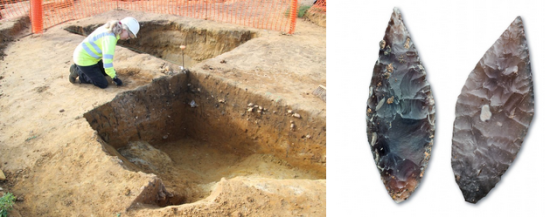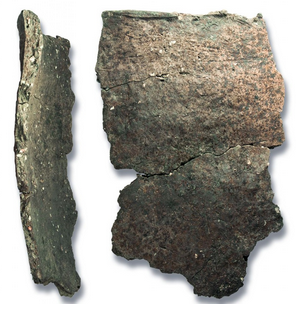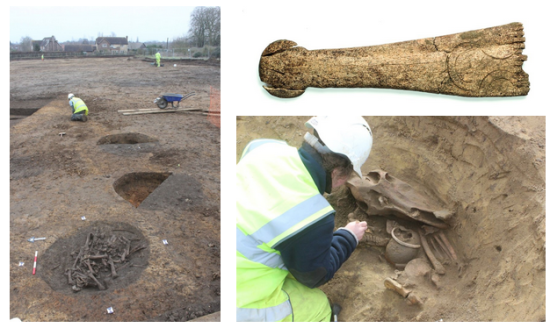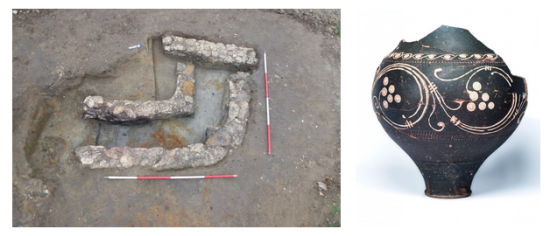Cotswold Archaeology
Source - http://www.cotswoldarchaeology.co.uk/important-discoveries-at-thame-oxfordshire/
At the end of August, Oxford Cotswold Archaeology (a joint venture between Oxford Archaeology and Cotswold Archaeology) completed the excavation of a site on the edge of Thame in Oxfordshire. The work was carried out in advance of new housing being built by Bloor Homes.
 At the outset, we knew that the site contained some significant Iron Age and Roman archaeology and there was even a hint, in the form of a single sherd of pottery, that Saxon features might also be present. In the event, the excavations far surpassed our expectations, revealing a complex, multi-period archaeological landscape with significant archaeological remains dating to the Neolithic, Iron Age, Roman and Saxon periods. Arguably the most exciting, and certainly the most unexpected, aspect was the discovery of a previously unknown causewayed enclosure. The newly discovered Thame causewayed enclosure is one of only 80 or so such monuments known in the country. Causewayed enclosures are of great significance in the Neolithic period and represent the earliest known enclosure of open space. They vary greatly in form, but are characterised by the nature of their perimeter earthworks. The ditches, and banks where these survive, were constructed in short lengths separated by undug ground. They do not appear to have been permanently occupied; rather, they were probably places where dispersed groups gathered periodically to carry out a range of activities, ritual or otherwise.
At the outset, we knew that the site contained some significant Iron Age and Roman archaeology and there was even a hint, in the form of a single sherd of pottery, that Saxon features might also be present. In the event, the excavations far surpassed our expectations, revealing a complex, multi-period archaeological landscape with significant archaeological remains dating to the Neolithic, Iron Age, Roman and Saxon periods. Arguably the most exciting, and certainly the most unexpected, aspect was the discovery of a previously unknown causewayed enclosure. The newly discovered Thame causewayed enclosure is one of only 80 or so such monuments known in the country. Causewayed enclosures are of great significance in the Neolithic period and represent the earliest known enclosure of open space. They vary greatly in form, but are characterised by the nature of their perimeter earthworks. The ditches, and banks where these survive, were constructed in short lengths separated by undug ground. They do not appear to have been permanently occupied; rather, they were probably places where dispersed groups gathered periodically to carry out a range of activities, ritual or otherwise.

 The Thame example has three roughly concentric ditch circuits enclosing an area of high ground overlooking the valley of the River Thame. Later in the Neolithic, a small henge monument was constructed within the causewayed enclosure. A second, smaller, ring-ditch was located close to the henge and this may also be of later Neolithic date. During the Bronze Age, the site saw virtually no activity or, at least, no activity which left a mark in the archaeological record. However, it is entirely possible that the site continued to play an important role in the lives of local communities. It was not until the early Iron Age that a settlement was built at the site, albeit largely on lower ground away from the causewayed enclosure. The remains of a substantial enclosure, roundhouses, clusters of pits and a number of granaries attest to the site’s use during this period
The Thame example has three roughly concentric ditch circuits enclosing an area of high ground overlooking the valley of the River Thame. Later in the Neolithic, a small henge monument was constructed within the causewayed enclosure. A second, smaller, ring-ditch was located close to the henge and this may also be of later Neolithic date. During the Bronze Age, the site saw virtually no activity or, at least, no activity which left a mark in the archaeological record. However, it is entirely possible that the site continued to play an important role in the lives of local communities. It was not until the early Iron Age that a settlement was built at the site, albeit largely on lower ground away from the causewayed enclosure. The remains of a substantial enclosure, roundhouses, clusters of pits and a number of granaries attest to the site’s use during this period
 During the Roman period a number of trackways were built, leading to the higher ground occupied by the causewayed enclosure. A series of enclosures were constructed off the trackways and these were adapted and modified to suit the needs of the occupants throughout the Roman period. Within the enclosures, at least six corn-drying ovens, along with a number of circular ovens and hearths, were built. Little evidence for substantial building has been found and it is likely that the site was an important centre for processing agricultural produce from the surrounding area throughout the period.
During the Roman period a number of trackways were built, leading to the higher ground occupied by the causewayed enclosure. A series of enclosures were constructed off the trackways and these were adapted and modified to suit the needs of the occupants throughout the Roman period. Within the enclosures, at least six corn-drying ovens, along with a number of circular ovens and hearths, were built. Little evidence for substantial building has been found and it is likely that the site was an important centre for processing agricultural produce from the surrounding area throughout the period.
 Following the end of the Roman period, the site was once again used for settlement. Thame is known to have been founded in the Saxon period and it is likely that the site was part of this settlement. Eleven sunken-featured buildings, dating to the 6th-7th century AD, were found at the site. Sunken-featured buildings are characteristic of the Saxon period and consist of roughly rectangular pits excavated into the ground. A posthole at either end provided support for the simple superstructure. It is generally thought that these buildings were workshops, and many of the Thame examples contained objects associated with weaving, such as loomweights, bone pins and spindlewhorls.
Following the end of the Roman period, the site was once again used for settlement. Thame is known to have been founded in the Saxon period and it is likely that the site was part of this settlement. Eleven sunken-featured buildings, dating to the 6th-7th century AD, were found at the site. Sunken-featured buildings are characteristic of the Saxon period and consist of roughly rectangular pits excavated into the ground. A posthole at either end provided support for the simple superstructure. It is generally thought that these buildings were workshops, and many of the Thame examples contained objects associated with weaving, such as loomweights, bone pins and spindlewhorls.
 We are particularly grateful to Gerry Wait of Nexus Heritage for advice throughout the project, and to Darren Pratt, Design and Technical Director for Bloor Homes South Midlands office, for his support.
We are particularly grateful to Gerry Wait of Nexus Heritage for advice throughout the project, and to Darren Pratt, Design and Technical Director for Bloor Homes South Midlands office, for his support.